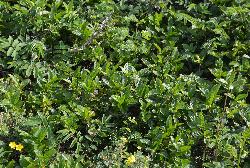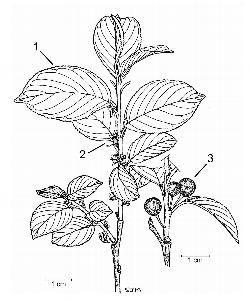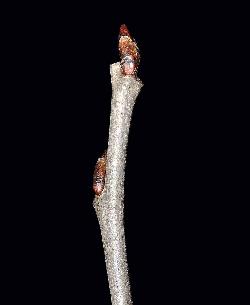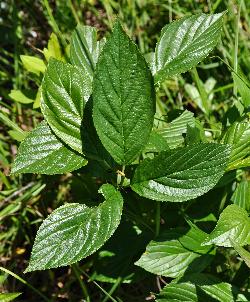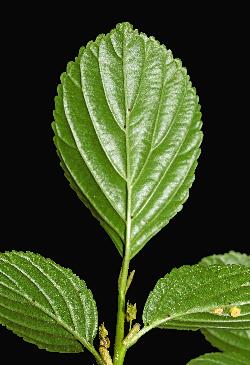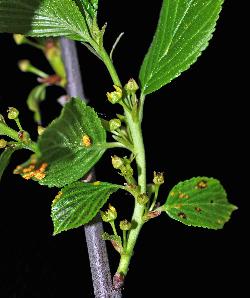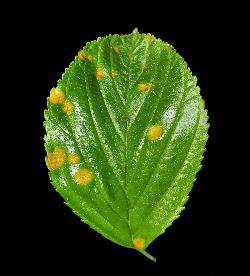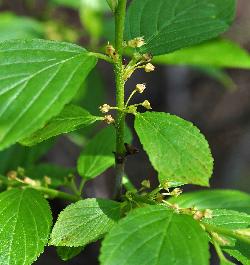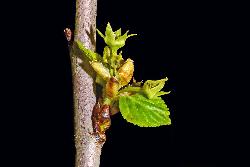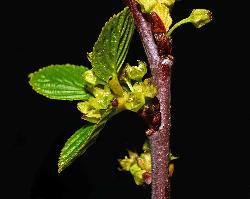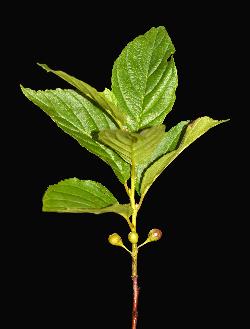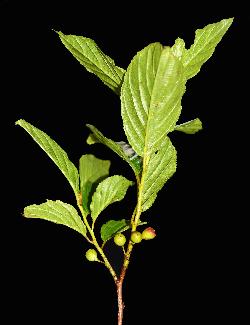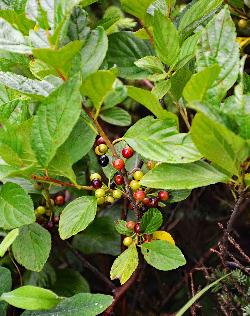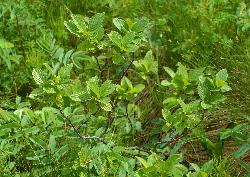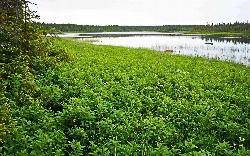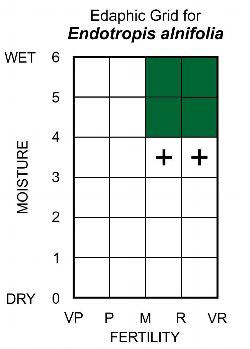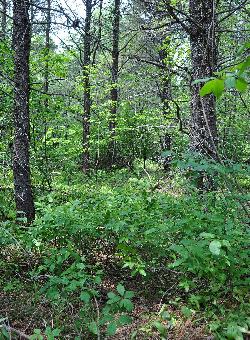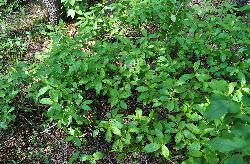Fr: nerprun à feuilles d'aulne, nerprun des marécages
Rhamnaceae - Buckthorn Family
Note: Numbers provided in square brackets in the text refer to the image presented above; image numbers are displayed to the lower left of each image.
General: A low deciduous shrub of wet habitats, 1.5–8 d m tall, preferring calcareous habitats and spreading by layering to produce extensive colonies [1–3]. Alderleaf buckthorn has small inconspicuous flowers and blackish fruits that are considered inedible due to their laxative and purgative effects, producing nausea and vomiting. While no reports of poisoning by fruits of alderleaf buckthorn have been found in the literature, related buckthorn species in mainland Canada, particularly the European buckthorn (Rhamnus cathartica L.) are known to be violently purgative and ingestion of 20 or more berries can produce serious problems (Munro 2013); the non-native European buckthorn is also highly invasive and should not be planted in gardens.
In the Newfoundland Forest Site Classification Manual (W.J. Meades and Moore 1989), alderleaf buckthorn was known as Rhamnus alnifolia L'Hér. Recently, this species was moved from the genus Rhamnus to the genus Apetlorhamnus, becoming Apetlorhamnus alnifolia (L'Hér.) Nieuwl. (Hauenschild et al. 2016a) But the genus name Apetlorhamnus was published 90 years later than the genus name Endotropis, therefore, the earlier name, Endotropis, has priority and this species is now correctly named Endotropis alnifolia (Hauenschild et al. 2016b).
Key Features: (numbers 1–3 refer to the illustration [4])
1. Leaves alternate, elliptic, ovate, or obovate, with 5–8 pairs of curved (arcuate) veins.
2. Flowers are functionally unisexual and yellow-green, with 4–5 calyx lobes; petals are lacking; flowers occur in small axillary clusters.
3. The fruit is an ovoid to globose purplish-black drupe with 1–3 flat seeds.
Stems/twigs: Older stems are grey and erect to decumbent, while young stems are erect, green, and finely pubescent. Woody twigs are reddish-brown to greyish brown. Terminal buds are lacking, lateral buds are alternate, scaly, and ovoid, usually with a blunt-pointed tip. The dark brown bud scales are 2-toned light and dark brown, and have minutely ciliate margins [5–6]. Leaf scars are hemispherical to nearly circular, but straight at the top, and have 3 bundle scars.
Leaves: Alternate, simple, stipulate, and petiolate. Leaf blades have 5-8 pairs of impressed and arcuate veins that curve towards the apex [7–9]. Stipules are oblong to linear and 6–9 mm long [8–9], but dehisce soon after the flowering period; petioles are 7–12 mm long and grooved above. Leaves on upper portions of each branch are generally larger than lower leaves [10]. Mature upper leaves are elliptic, ovate, to obovate, and 2–10 cm long by up to 5 cm wide, with tapering (cuneate) bases and blunt, acute, or abruptly acuminate apices. Lower leaves are shorter and broader, with orbicular to ovate blades, rounded bases, and rounded to blunt apices. Leaf margins are crenate-serrate with minute glands at the tip of each in-curved tooth. Upper leaf surfaces are yellow-green to dark green and slightly paler beneath. Young leaves are minutely pubescent along lower veins and on the upper surface of the petiole, but mature leaves and petioles are glabrous. Inner bud scales seem to grade into stipules, with lower leaves subtended by oblong scale-like stipules, often brown in the upper half, while stipules subtending upper leaves are pale green and narrower (oblanceolate to linear) [10]; both bud scales and stipules have ciliate margins. Leaves turn yellow in autumn.
Alderleaf buckthorn is an alternate host to the oat crown rust (Puccinia coronata Corda f. sp. avenae Eriks. and Henn.), which causes orange pustules (aecia) to develop on the leaves and flowers of buckthorn species [11–12]. The primary host plants of oat crown rust are oats, barley, and rye, but many common native grasses may also be infected, such as slender wildrye (Elymus trachycaulus (Link) Gould ex Shinners), reed canarygrass (Phalaris arundinacea L.), and fescues (Festuca spp.). Basidiospores produced on these grasses are dispersed long distances by wind and infect buckthorn species, on which the pycnial and aecial stages of the rust develop. When the aecia on buckthorn plants mature, aeciospores are released and go on to infect susceptible grass species, restarting the rust infection cycle (Simons 1985, Martinelli 2004, Fetch et al. 2011).
Flowers: Unisexual, with functionally male or female flowers on different shrubs (plants dioecious), but small non-functional stamens or pistils are also present, respectively, on functionally unisexual female or male flowers (plants polygamodioecious). The small yellowish-green flowers, 3–5 mm across, are arranged in axillary clusters of 2–5, and have a calyx with 4–5 triangular calyx lobes, but no petals [13–15]. Male (staminate) flowers have 4–5 stamens [16]; female (pistillate) flowers have a single pistil with a superior ovary topped by a sessile, 3-lobed stigma and surrounded by a broad nectariferous disc [17]. Flowers bloom in June to early July, with the expanding leaves. As in other buckthorn species, pollination is by a variety of insects (entomophily), primarily bees and flies (Zouhar 2011).
Fruit: A smooth ovoid berry-like drupe, inedible, green to red when immature [18–19], purplish-black at maturity [20–21]. Fruits are 6–8 mm in diameter, borne on short peduncles, and contain 1–3 seeds, each inside a small pit (endocarp). The flesh is mucilaginous, bitter tasting, and capable of producing nausea, vomiting, and diarrhea (Glenn 2013), but no reports of serious injury have been found in the literature. Fruits mature in late August to September; dispersal is by frugivorous birds (endozoochory).
Ecology and Habitat: Alderleaf buckthorn occurs in open habitats on wet nutrient-rich soils associated with forested fens and alder swamps; it prefers calcareous habitats. Its absence from closed forests suggests it is shade-intolerant. Alderleaf buckthorn is very common on the Great Northern Peninsula; it occurs in moist ravines throughout the limestone barrens, as far north as the tip of the peninsula [22–23], and in marshy borders of marl ponds and lakeshores adjacent to forests over limestone, especially in the area between Main Brook and Roddickton [24].
Edaphic Grid: See image [25]: the Edaphic Grid for Endotropis alnifolia.
Forest Types: Alderleaf buckthorn has been recorded from the following forest types:
Betuletum typicum (White Birch on unstable soils Subassociation)
Carici-Piceetum (Carex-Black Spruce Swamp Association)
Osmundo-Piceetum (Osmunda-Black Spruce Swamp Association)
Alneto-Piceetum (Alder-Black Spruce Swamp Association)
Succession: Alderleaf buckthorn is poorly researched with respect to its response to disturbance. Wildfire would be rare in the wet habitats it prefers, and harvesting would also be unlikely given the low abundance and poor tree growth. Its absence from closed forest types suggests alderleaf buckthorn is not tolerant to shade, but it does occur in the understorey of alder swamps. Alderleaf buckthorn has the capacity to recover from natural disturbance through vegetative layering, and will persist after logging and reforestation. In one example from the Algoma District of Ontario, where a bog had been burned and later planted with jack pine, alderleaf buckthorn persisted in the understorey, despite the subsequent change in moisture regimes and cover [26–28].
Distribution: Alderleaf buckthorn is native to north-temperate and boreal North America, with a Canadian range that extends from Newfoundland west to southeastern British Columbia; it occurs as far north as 58° 43’ N in Alberta (Scoggan 1978). In insular Newfoundland, alderleaf buckthorn is found throughout western Newfoundland, extending from the Great Northern Peninsula to southwest Newfoundland, and east to the Gambo area (Rouleau and Lamoureux 1992). It is absent from south-central and eastern Newfoundland, as well as Labrador. In the United States, alderleaf buckthorn occurs across the northern States, extending from New England southwest along the Appalachians to northern Tennessee, and west along the contiguous border States to eastern North Dakota. Few county locations are reported from South Dakota, Wyoming, and Utah, but a western range occurs in the Rockies from Montana, Idaho, and Washington, south to the Sierra Nevada Mountains in northern California (USDA, NRCS 2016).
Similar Species: Due to their arcuate veins, the leaves of alderleaf buckthorn may be mistaken with those of Cornus (dogwood) species, but alderleaf buckthorn leaves are alternate with crenate-serrate margins, while the leaves of red-osier dogwood are opposite with entire margins or, in alternateleaf dogwood, the leaves are alternate with long petioles and entire margins.
The leaves of alderleaf buckthorn may also be confused with those of mountain alder (Alnus alnobetula subsp. crispa), but the straight pinnate veins of mountain alder terminate at the leaf margin and do not curve upward toward the leaf apex; also, the leaf margins are coarsely serrate, with pointed, not curved, teeth. The flowering catkins and woody cone-like fruiting catkins in which the winged nutlets develop make differentiation quite easy between mountain alder and alderleaf buckthorn.
.




